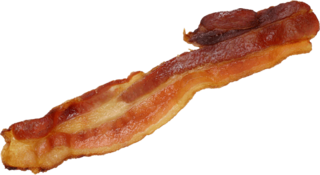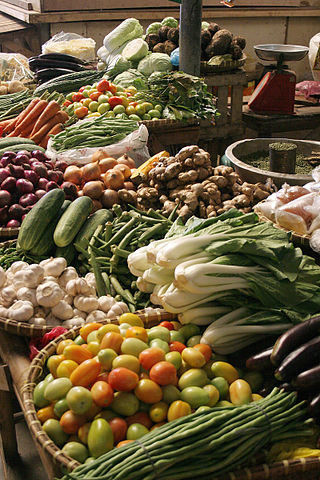Spam is a brand of salty processed canned pork and ham made by Hormel Foods Corporation. It was introduced in 1937 and gained popularity worldwide after its use during World War II. By 2003, Spam was sold in 41 countries on six continents. In the U.S., Hawaii is the state with the highest per capita consumption of Spam. It has become a common ingredient in Hawaiian cuisine.

Pantothenic acid (vitamin B5) is a B vitamin and an essential nutrient. All animals need pantothenic acid in order to synthesize coenzyme A (CoA)—essential for metabolizing fatty acid—and to synthesize and metabolize proteins, carbohydrates, and fats.

Bacon is a type of salt-cured pork made from various cuts, typically the belly or less fatty parts of the back. It is eaten as a side dish, used as a central ingredient, or as a flavouring or accent.
A nutrient is a substance used by an organism to survive, grow, and reproduce. The requirement for dietary nutrient intake applies to animals, plants, fungi, and protists. Nutrients can be incorporated into cells for metabolic purposes or excreted by cells to create non-cellular structures, such as hair, scales, feathers, or exoskeletons. Some nutrients can be metabolically converted to smaller molecules in the process of releasing energy, such as for carbohydrates, lipids, proteins, and fermentation products, leading to end-products of water and carbon dioxide. All organisms require water. Essential nutrients for animals are the energy sources, some of the amino acids that are combined to create proteins, a subset of fatty acids, vitamins and certain minerals. Plants require more diverse minerals absorbed through roots, plus carbon dioxide and oxygen absorbed through leaves. Fungi live on dead or living organic matter and meet nutrient needs from their host.

A food pyramid is a representation of the optimal number of servings to be eaten each day from each of the basic food groups. The first pyramid was published in Sweden in 1974. The 1992 pyramid introduced by the United States Department of Agriculture (USDA) was called the "Food Guide Pyramid" or "Eating Right Pyramid". It was updated in 2005 to "MyPyramid", and then it was replaced by "MyPlate" in 2011.
In the U.S. and Canada, the Reference Daily Intake (RDI) is used in nutrition labeling on food and dietary supplement products to indicate the daily intake level of a nutrient that is considered to be sufficient to meet the requirements of 97–98% of healthy individuals in every demographic in the United States. While developed for the US population, it has been adopted by other countries, though not universally.
The Dietary Reference Intake (DRI) is a system of nutrition recommendations from the National Academy of Medicine (NAM) of the National Academies. It was introduced in 1997 in order to broaden the existing guidelines known as Recommended Dietary Allowances. The DRI values differ from those used in nutrition labeling on food and dietary supplement products in the U.S. and Canada, which uses Reference Daily Intakes (RDIs) and Daily Values (%DV) which were based on outdated RDAs from 1968 but were updated as of 2016.

Lunch meats—also known as cold cuts, luncheon meats, cooked meats, sliced meats, cold meats, sandwich meats, delicatessens, and deli meats—are precooked or cured meats that are sliced and served cold or hot. They are typically served in sandwiches or on a tray. They can be purchased pre-sliced, usually in vacuum packs, or they can be sliced to order.

Food processing is the transformation of agricultural products into food, or of one form of food into other forms. Food processing takes many forms, from grinding grain into raw flour, home cooking, and complex industrial methods used in the making of convenience foods. Some food processing methods play important roles in reducing food waste and improving food preservation, thus reducing the total environmental impact of agriculture and improving food security.

Saponification value or saponification number represents the number of milligrams of potassium hydroxide (KOH) or sodium hydroxide (NaOH) required to saponify one gram of fat under the conditions specified. It is a measure of the average molecular weight of all the fatty acids present in the sample in form of triglycerides. The higher the saponification value, the lower the fatty acids average length, the lighter the mean molecular weight of triglycerides and vice versa. Practically, fats or oils with high saponification value are more suitable for soap making.

Pancetta is a salt-cured pork belly meat, product in a category known as salume. In Italy, it is often used to add depth to soups and pastas.

Grape leaves, the leaves of the grapevine plant, are used in the cuisines of a number of cultures. They may be obtained fresh, or preserved in jars or cans. The leaves are commonly rolled or stuffed with mixtures of meat and rice to produce dolma, found widely in the Mediterranean, Balkans, and Middle East. They may also be used in various other recipes and dishes. When cut into smaller pieces they are used as a savory addition to soups that include greens and cabbage.

Lay's is a brand of potato chips with different flavors, as well as the name of the company that founded the chip brand in the United States. The brand is also referred to as Frito-Lay, as both Lay's and Fritos are brands sold by the Frito-Lay company, which has been a wholly owned subsidiary of PepsiCo since 1965.
Health Check was a certification program operated by the Heart and Stroke Foundation of Canada. First established in 1999, the program allowed food products that met predetermined nutritional guidelines to be marketed using a Health Check seal, identifying the product as being endorsed by the Heart and Stroke Foundation. Distributors and restaurants were required to pay a fee to the Heart and Stroke Foundation to license the logo.

The nutrition facts label is a label required on most packaged food in many countries, showing what nutrients and other ingredients are in the food. Labels are usually based on official nutritional rating systems. Most countries also release overall nutrition guides for general educational purposes. In some cases, the guides are based on different dietary targets for various nutrients than the labels on specific foods.

Vegetables are parts of plants that are consumed by humans or other animals as food. The original meaning is still commonly used and is applied to plants collectively to refer to all edible plant matter, including the flowers, fruits, stems, leaves, roots, and seeds. An alternative definition of the term is applied somewhat arbitrarily, often by culinary and cultural tradition. It may exclude foods derived from some plants that are fruits, flowers, nuts, and cereal grains, but include savoury fruits such as tomatoes and courgettes, flowers such as broccoli, and seeds such as pulses.

Potted meat is a form of traditional food preservation in which hot cooked meat is placed in a pot, tightly packed to exclude air, and then covered with hot fat. As the fat cools, it hardens and forms an airtight seal, preventing some spoilage by airborne bacteria. Before the days of refrigeration, potted meat was developed as a way to preserve meat when a freshly slaughtered animal could not be fully eaten immediately.

Dry cocoa solids are the components of cocoa beans remaining after cocoa butter, the fatty component of the bean, is extracted from chocolate liquor, roasted cocoa beans that have been ground into a liquid state. Cocoa butter is 46% to 57% of the weight of cocoa beans and gives chocolate its characteristic melting properties. Cocoa powder is the powdered form of the dry solids with a small remaining amount of cocoa butter. Untreated cocoa powder is bitter and acidic. Dutch process cocoa has been treated with an alkali to neutralize the acid.

Turkey bacon is a meat prepared from chopped, formed, cured, and smoked turkey, commonly marketed as a low-fat alternative to pork bacon; it may also be used as a substitute for bacon where religious dietary laws forbid the consumption of pork products.

Alligator meat is the meat from alligators that is for consumption. It has been used both historically and in contemporary times in various cuisines of the Southern United States. Alligator eggs can also be consumed. Alligator meat is high in protein and low in fat, and has a mild flavor and firm texture.















